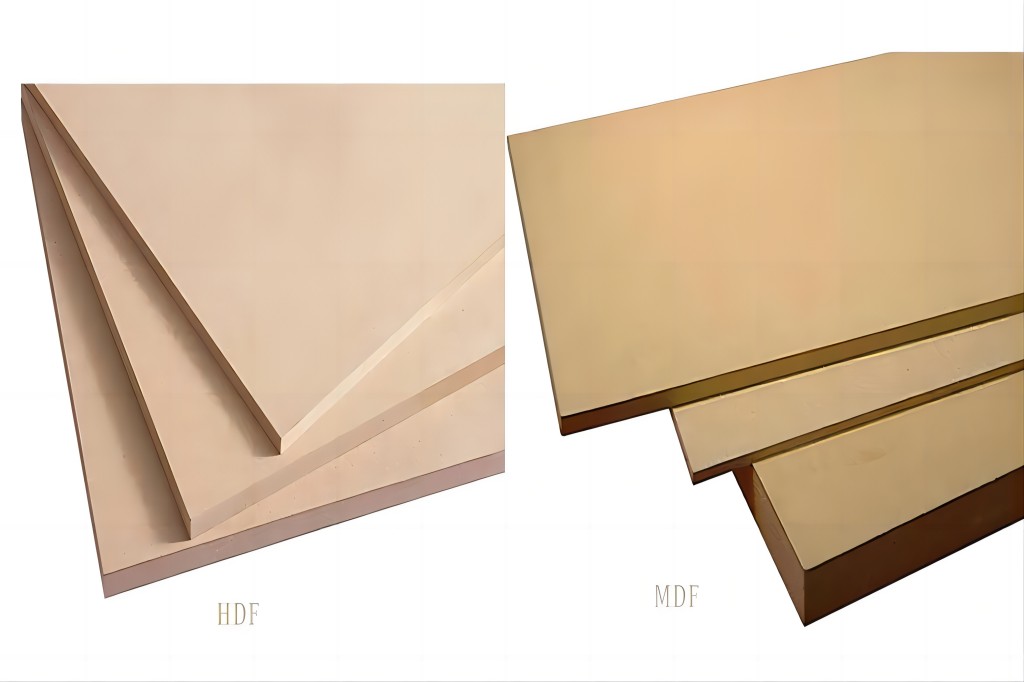In the field of engineered wood products, high-density fiberboard (HDF) and medium-density fiberboard (MDF) are two important materials used in a wide range of industries, including furniture manufacturing, flooring and cabinetry. Although HDF and MDF are of similar origin (both are made from compressed wood fibers), they have different properties that serve different needs and applications.
We took an in-depth look at the differences between HDF and MDF, looking at their production processes, physical properties, common uses, and factors to consider when choosing between the two. Helps when making decisions
Table of Contents
ToggleProduction Process
Both HDF and MDF are engineered wood products made from wood residuals mixed with wax and resin binder. The primary distinction is in the density of the wood fibers employed.HDF employs more densely compressed wood fibers, making it a denser and harder material than MDF. This increased density is achieved by using finer wood fibers and applying more pressure during the manufacturing process.
Physical Properties
The density of a fiberboard largely determines its strength and durability. HDF typically has a density of 800 kg/m³ or more, whereas MDF usually ranges between 600 to 800 kg/m³. This higher density makes HDF more resistant to wear and tear and less susceptible to swelling and deformation under high humidity conditions compared to MDF.
Hardness and Durability:
HDF’s superior hardness makes it an ideal choice for applications where high durability is necessary, such as in flooring. It has greater resistance to impact and pressure, thus minimizing the chances of dents and scratches.MDF, while still quite durable, is softer and may not hold up as well under similar stresses.
Moisture Resistance:
HDF provides superior moisture resistance compared to MDF. This characteristic makes it suitable for use in more humid environments or in applications like bathroom cabinetry, where exposure to moisture is frequent.
Surface Finish:
MDF’s smoother surface makes it excellent for painting and veneering. It can be easily sanded to a very smooth finish, allowing for a superior paint application that is often preferred for decorative purposes. HDF, though it can also be finished nicely, typically requires more preparation for a smooth surface.
Feature | High-Density Fiberboard (HDF) | Medium-Density Fiberboard (MDF) |
Density | Typically 800 kg/m³ or higher | Typically 600–800 kg/m³ |
Strength | Higher strength due to higher density | Good strength, but generally lower than HDF |
Durability | More durable, resistant to wear and tear | Less durable compared to HDF |
Moisture Resistance | Higher moisture resistance, more suitable for damp environments | Moderate moisture resistance, can swell or warp in high moisture |
Weight | Heavier, which might complicate handling and installation | Lighter, easier to handle and cut |
Workability | Harder to work with due to its density; requires more robust tools | Easier to cut and shape; more flexible in terms of tooling |
Cost | Generally more expensive than MDF | Less expensive, more cost-effective |
Surface Smoothness | Smooth surface suitable for detailed millwork and coatings | Very smooth surface, excellent for painting and veneers |
Thermal and Acoustic Properties | Generally better sound and thermal insulation due to higher density | Good thermal and acoustic insulation but slightly less effective than HDF |
Common Uses
HDF:
- Flooring: Its high density and durability make it suitable for use in engineered wood flooring and laminate flooring.
- Doors: The strength of HDF supports the structural integrity of doors, making them more robust and stable.
- Backer boards for countertops and cabinets: The moisture resistance of HDF makes it perfect for damp-prone areas.
MDF:
- Furniture: The ease of cutting and shaping MDF makes it ideal for manufacturing intricate furniture designs.
- Cabinetry: The material’s smooth finish is perfect for painted cabinets and decorative panels.
- Crafting and molding: MDF’s consistency and smoothness make it a favorite for decorative moldings, craft projects, and detailed architectural elements.
Environmental Impact and Safety
Both HDF and MDF are considered more environmentally friendly compared to traditional solid woods because they are manufactured from recycled wood fibers. However, the binding resins employed may emit formaldehyde, a recognized irritant and carcinogen.The industry has moved towards lower formaldehyde-emitting resins, but it is still something to be aware of, especially in confined spaces.
Choosing Between HDF and MDF
The choice between HDF and MDF should be based on the specific requirements of the project. Consider factors such as:
- Environmental Conditions: If the product will be exposed to moisture or require higher durability against wear, HDF is the better choice.
- Finish and Aesthetics: For projects requiring a fine, smooth finish, particularly if painting or veneering is involved, MDF may be more suitable.
- Cost: Typically, MDF is less expensive than HDF, making it a cost-effective option for many interior applications.
Both High-Density Fiberboard and Medium-Density Fiberboard are versatile materials with distinct advantages. While HDF provides superior durability and moisture resistance ideal for flooring and heavy-duty applications, MDF’s smooth finish and ease of manipulation make it perfect for detailed and decorative projects.By comprehending the distinct characteristics and advantages of each, manufacturers and consumers can make knowledgeable choices that align with their requirements and financial limitations.

